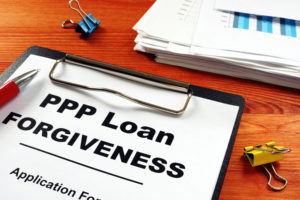
In last week’s blog, we discussed the continuing confusion surrounding the deductibility of eligible expenses by small businesses who have received loans through the Paycheck Protection Program (PPP). While that situation has yet to be fully resolved, another aspect of the PPP program, applying for loan forgiveness, is a bit clearer cut.
You might ask, “why are you writing about the PPP loan forgiveness in a multistate tax blog?” The answer is simple. One of the things we are proudest of, in our state tax consulting space, is that we too, are a small business. And we’ve had first-hand experience in working through the complexities of this process. We felt it was important enough from a national small business perspective to warrant some dedicated space!
Loans through the PPP are applicable for forgiveness, but to be forgiven, the funds must be used to cover the following:
- Payroll costs, including benefits (up to $15,385 per worker)
- Interest on mortgage obligations, entered into before February 15, 2020
- Rent, under lease agreements in force before February 15, 2020
- Utilities, for which service began before February 15, 2020
In addition, employee and compensation levels must be maintained, or employees must be quickly rehired. Plus, no more than 25 percent of the forgiven amount may be for non-payroll costs.
To ensure small businesses owners will not be required to pay back large portions of PPP loans, it’s important they calculate eligible expenses. In the weeks since the implementation of the PPP, many business owners have anxiously awaited further guidance regarding the application process and exact information regarding calculating loan forgiveness.
On May 15, the Treasury Department and the Small Business Authority released a Loan Forgiveness Application, which includes instructions and additional information for business owners.
By following the directions as described in the application, business owners will be able to calculate their forgiveness amount and submit required documentation.
Keeping accurate records regarding total eligible costs during the 8-week covered period after receiving loan funding is critical to securing loan forgiveness.
The main considerations for loan forgiveness are:
- The amount of funds used for eligible payroll: If payroll equates less than 75 percent, loan forgiveness will be reduced.
- Average Full-Time Employees (FTE): If the average weekly number of full-time employees during the covered period of the PPP loan was less than either Feb. 15 – June 30, 2019 or Jan 1 – Feb 29, 2020, loan forgiveness may be reduced. Seasonal employers can use a consecutive 12-week period between May 1 – Sept. 15, 2019.
- Salary and hourly wage reductions: If salary or hourly wages of certain employees during the covered period was less than from Jan. 1 – March 31, 2020, the amount of loan forgiveness may be reduced.
- Full-Time Employee Reduction Exceptions: Good-faith, written offers to rehire employees during the covered period that were rejected, or employees who were fired for cause, voluntarily resigned or voluntarily requested a reduction of hours will not count against loan forgiveness.
In addition to filling out the form and submitting it to their lender (or the lender servicing their loan), small business owners will be required to submit supporting documentation detailing payroll costs, FTE information and details verifying obligations for mortgage interest payments, rent or lease payments and business utility payments.
If you have questions regarding the PPP and loan forgiveness, please contact us today. We’re happy to clarify any multi-state or PPP/CARES tax issues you’re trying to navigate.
The Miles Consulting team is wishing you and your family continued good health and safety in these trying times.


















